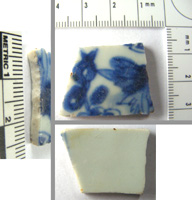Porcelain

Click ^ for larger image.
There are many sorts of pottery, and one of the more recent developments is porcelain, whose high firing temperature was difficult to create and control (the technique originated in China). Sherds of porcelain are most easily identified by looking at their broken edges, which have a glassy lustre rather than the dull clay fabric of ordinary pottery. In porcelain the clay has been vitrified - literally turned to glass - by the intense heat in the kiln.
This typical example of a blue and white pattern depicts a floral theme, and has the characteristic fuzzy edges of Flow Blue, which is where the blue cobalt has spread out into the glaze during firing. British potters trying to emulate the crisp patterns of Chinese porcelain regarded such flowing as a defect, but it actually achieved some popularity in the 19th century (especially in America) as it lent a misty ambience to the painted scenes, redolent of the mysterious Orient.
Material: ceramic
Period: Modern
Find spot: Eastwood Farm, Brislington, ST 6371
Exhibit contributed by Dave Setter & Rod Webb
Text written by Ken Taylor, 2012
Photographer: Ken Taylor
Acquisition number: 120224a8